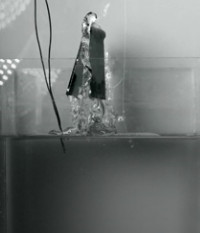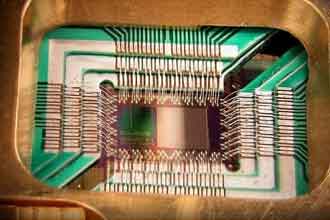Some animals can jump out of water from a standing start, without anything to push against except the water.

A pair of researchers at Cornell University – Sunghwan Jung and Brian Chang – wanted to know how, and could a robot do it.
“We collected data about aquatic animals of different sizes – from about 1mm to tens of meters – jumping out of water, and were able to reveal how their maximum jumping heights are related to their body size,” said Jung. “since water is 1,000 times denser than air, entering or exiting water requires a lot of effort, so aquatic animals face mechanical challenges.”
One limit to jump height is ‘entrained water mass’ – An object, be it dolphin or a little crustacean called a copepod, sweeps water along with it when it jumps, the amount depending on the shape, size and velocity of the animal.

Streamlined aquatic animals shed most of the water as them move, allowing them to jump high.
However, asked the researchers, how do non-streamlined creatures like frogs and copepods get rid of the water, and what else do they do?
“We’re trying to understand how biological systems are able to overcome challenges to maximise their performance, which might also shed light on engineering systems to enter or exit air-water interfaces,” said Jung.
The team found out, and designed a small hinged mechanism which is snapped shut by a rubber band.
Once 3d-printed, it worked – and there is a video to prove it, from which the photos on the right are taken.
“This robot shows the importance of entrained water while an object jumps out of the water,” said Jung.
The work is being presented this week at the American Physical Society’s Division of Fluid Dynamics Annual Meeting in Georgia, in a paper called ‘How aquatic animals leap out of water’ (presentation M20.2).

Away from entrained water, according to the paper’s abstract: “By balancing power produced by the animal with drag-induced dissipation, we show that the normalized jumping height, H/L, scales with the Froude number as H/L∼Fr2. Simplified experiments were conducted by shooting axisymmetric bodies through the water surface. Here, we see a transition in which partial exits scale as H/L∼Fr and complete exits scale as H/L∼Fr2.”
Next on the group’s agenda is attaining heights similar to copepods and frogs.
Images from AIP via Eurekalert
Source from:electronicsweekly

 Englisch
Englisch  Chinesisch
Chinesisch  Deutsch
Deutsch  Koreanisch
Koreanisch  Japanisch
Japanisch  Farsi
Farsi  Portuguese
Portuguese  Russian
Russian  Spanisch
Spanisch 





